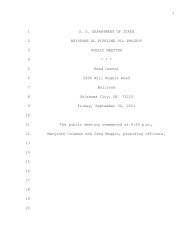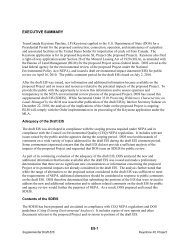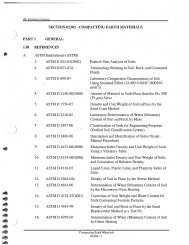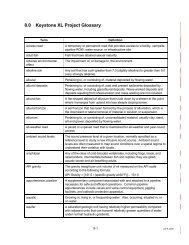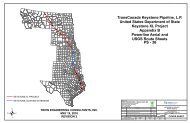2.1 Overview of the Proposed Project - Keystone XL pipeline - US ...
2.1 Overview of the Proposed Project - Keystone XL pipeline - US ...
2.1 Overview of the Proposed Project - Keystone XL pipeline - US ...
Create successful ePaper yourself
Turn your PDF publications into a flip-book with our unique Google optimized e-Paper software.
Draft Supplemental Environmental Impact Statement<strong>Keystone</strong> <strong>XL</strong> <strong>Project</strong>PHMSA regulations at 49 CFR 195.450 and Special Condition 14 require that <strong>pipeline</strong> operatorsidentify areas along <strong>the</strong> proposed <strong>pipeline</strong> corridor that would be considered HCAs. While some<strong>of</strong> <strong>the</strong>se areas need to be defined through sophisticated risk modeling, in general <strong>the</strong>y are specificlocales where an accidental spill from a hazardous liquid <strong>pipeline</strong> could produce significantadverse consequences as described in 49 CFR 195.450.HCAs include navigable waterways, high population areas, and unusually sensitive areas.<strong>Keystone</strong> would need to identify <strong>the</strong> HCAs along <strong>the</strong> proposed route. Population changes along<strong>the</strong> route would be monitored throughout <strong>pipeline</strong> operation and any additional HCAs identifiedas necessary. <strong>Keystone</strong> would conduct a <strong>pipeline</strong> integrity management program in HCAs asrequired by 49 CFR 195.452 (Pipeline Integrity Management in HCAs).All maintenance work would be performed in accordance with PHMSA requirements, <strong>the</strong>applicable PHMSA Special Conditions, and <strong>the</strong> stipulations in environmental permits issued for<strong>the</strong> proposed <strong>Project</strong>. Woody vegetation along <strong>the</strong> permanent easement would be clearedperiodically in order to maintain accessibility for <strong>pipeline</strong> integrity surveys. Mechanical mowingor cutting would be carried out from time to time as needed along <strong>the</strong> permanent easement fornormal vegetation maintenance. Cultivated crops would be allowed to grow in <strong>the</strong> permanenteasement, but trees would be removed from <strong>the</strong> permanent ROW in all areas. In areasconstructed using <strong>the</strong> HDD method, trees would be cleared as required on a site specific basis.Permanent erosion control devices would be monitored to identify any areas requiring repair.The remainder <strong>of</strong> <strong>the</strong> ROW would be monitored to identify areas where additional erosioncontrol devices would be necessary to prevent future degradation. The ROW would be monitoredto identify any areas where soil productivity has been degraded as a result <strong>of</strong> <strong>pipeline</strong>construction. In <strong>the</strong>se areas, reclamation measures would be implemented to rectify <strong>the</strong>problems.Operation and maintenance <strong>of</strong> <strong>the</strong> proposed <strong>pipeline</strong> system would typically be accomplished by<strong>Keystone</strong> personnel. The permanent operational <strong>pipeline</strong> workforce would comprise about50 employees strategically located along <strong>the</strong> length <strong>of</strong> <strong>the</strong> <strong>pipeline</strong> in <strong>the</strong> United States: 35<strong>Keystone</strong> employees plus 15 contractual workers.<strong>2.1</strong>.11.2 Abnormal Operations<strong>Keystone</strong> would implement Abnormal Operating Procedures in accordance with 49 CFR Section195.402(d). Those procedures would be developed and documented in a manual as required by49 CFR 195.402. The manual would include procedures to provide safety when operating designlimits have been exceeded. That would include investigating and correcting <strong>the</strong> cause <strong>of</strong>unintended closure <strong>of</strong> valves or shutdowns, increases or decreases in pressure or flow rateoutside normal operating limits, loss <strong>of</strong> communications, operation <strong>of</strong> any safety device, and anyo<strong>the</strong>r malfunction <strong>of</strong> a component, deviation from normal operation, or personnel error whichcould cause a hazard to persons or property. Procedures would also include checking variationsfrom normal operation after abnormal operation has ended at sufficient critical locations in <strong>the</strong>system to accomplish <strong>the</strong> following:• Assure continued integrity and safe operation;• Identify variations from normal operation <strong>of</strong> pressure and flow equipment and controls;• Notify responsible operator personnel when notice <strong>of</strong> an abnormal operation is received;<strong>Project</strong> Description <strong>2.1</strong>-66 March 2013



